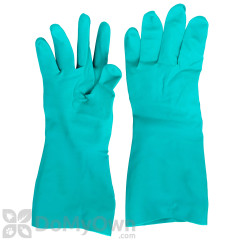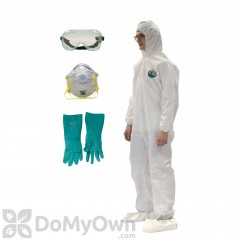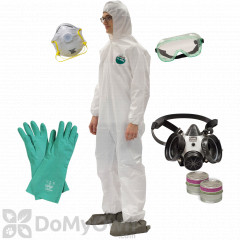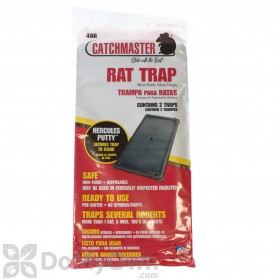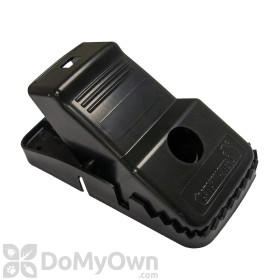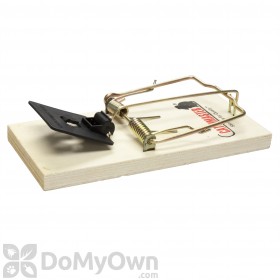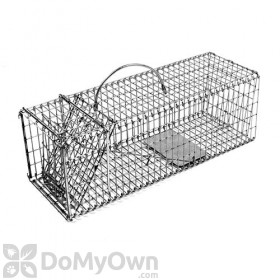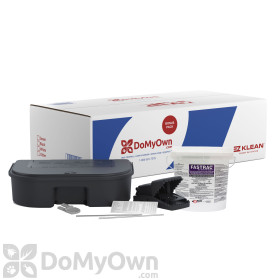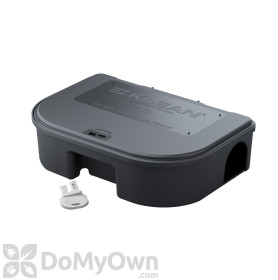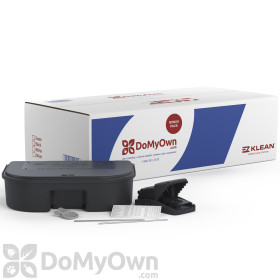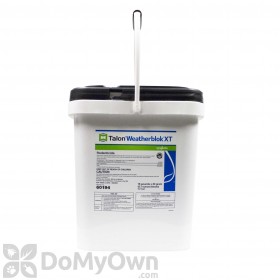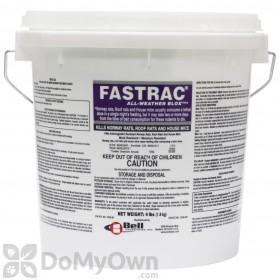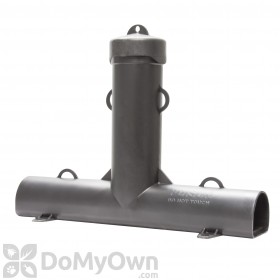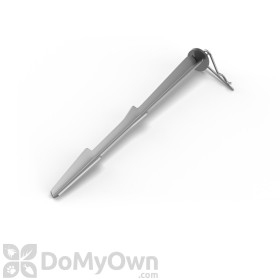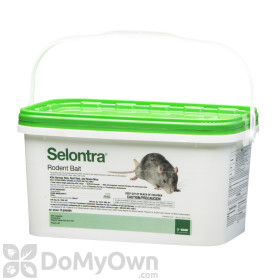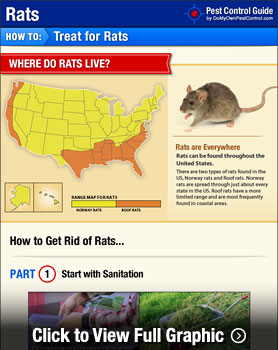Sanitation & Removal
Select a method below to understand how they help with removing rats, or continue reading to learn how to get rid of rats in three steps.
Get Rid of What Rats Need to Survive
- Store any bulk food items in large metal containers with tight fitting lids, rather than bags or boxes that can easily be gnawed through.
- Keep dog food or other pet food stored in a Rubbermaid container overnight.
- Remove clutter such as paper and cardboard that rats might use to build their nests.
- Remove grass clippings and yard debris near the structure.
- Trim up shrubs and bushes so they do not touch your home and so you can see beneath them.
- Store firewood away from the structure.
- Pick up fruit and nuts that fall from trees.
Indoor Rat Control
How to Get Rid of Rats in Your House
Method 1: Glue Traps, Snap Traps, and Live Catch Traps
Products needed : selected trap, bait for trapTrapping is the preferred method of indoor control. There are several advantages to using traps for rat removal indoors. Trapping does not require the use of rat poisons indoors. Trapping does allow you to know if a rat has been trapped, so that you can be sure your efforts are working. And last, trapping allows you to remove the carcass to avoid bad odors and secondary insect infestations from decaying carcasses.
Snap traps:A snap rat trap is a wooden, metal, or plastic trap with a powerful snap hinge intended to kill rodents quickly. Snap traps are typically used with some form of bait to lure the rodent to the trap.
Snap traps should be placed in areas where you noticed activity during your inspection. To maximize the chances of rodents passing over traps during their travels, traps should be placed perpendicular to the wall with the trigger end almost touching the wall. Alternatively, you can place a pair of traps end to end, parallel to the wall, with the triggers positioned to intercept rodents traveling from either direction.The right bait will lure rodents to the snap trap, especially when most other food sources have been eliminated through proper sanitation.
The ideal baits for rats and other rodents are those that give off an aroma, such as bacon, canned tuna, nuts, or nut butters. Mouse and rat attractants made for this use also work well. Peanut butter is a common recommendation for this use, but oils from the food can damage some traps over time. Check the trap manufacturer's bait recommendations before use.
When using solid baits, tie the bait to the trigger. This will prevent rodents from being able to remove unsecured bait without setting off the trap.
Where other food sources are abundant and cannot be eliminated, soft nesting material such as dental floss, cotton, or Styrofoam tied to the trigger may do the trick.Glue Traps:
A rat glue trap is a flat piece of cardboard or a shallow plastic tray that is covered in a specially designed adhesive that can be placed flush against floors and walls where rodents travel. When rats travel over the glue trap, they become "stuck" and will eventually die. Some traps come pre-scented to help lure the rodents to walk over the trap. In most cases, simply placing the trap flush against the wall in areas where rats have been active is all that is needed.Live Catch Traps:
Live catch rat traps (also known as humane traps) look like small wire cages. On one end is a door that you prop open. Once the rat goes into the trap, they will stand on a pedal to eat the bait that has been placed inside. Once the pedal has been tripped, the door will slam closed and the rat will be humanely trapped. You can bait the trap with the same types of bait used in snap traps. You will need to check with your local authorities to see what the ordinances are on catching and releasing rats in your region. Live catch trapping is not effective if you have a large infestation or if you are trying to trap small juvenile rats.Method 2: Rodenticide Baiting
While you can use rat bait poison indoors, we strongly urge you not to do so. After a rat consumes a lethal dose of the bait, it is possible that the animal can get into an area that is inaccessible making removing the carcass impossible. This can lead to a terrible odor and a secondary insect infestation. If you choose to bait inside, please place rat bait inside tamper resistant bait stations and place the stations out of reach of non-target animals and children. You should remove rat carcasses as soon as they are located.Myths revealed:
There is no such product that will cause rodents to go outside of a building, go outside to seek water (they already have water inside!) or dry up so they do not have an odor when they die. These myths were likely introduced by unscrupulous salesmen to get homeowners to allow the baits to be used inside their homes.Pro Tip
In areas where rats have been nesting in attics or basements and are using exposed beams to travel, you can secure Trapper T Rex traps to the beam with a zip tie.
In some cases, you may run into a rodent that seems to avoid your traps at all costs, perhaps because of narrowly escaping a trap in a previous encounter. This will require a more clever strategy. One method is to camouflage the trap by first burying an unset trap in grain, straw, or sawdust in a shallow pie pan. Baits should be placed in 3 to 4 small pieces on top of the pan with the trap hidden. Once the rodent accepts these baits without issues for several nights, the same bait can be used on the set trap
Products needed for Step 2
Outdoor Rat Control
How to Get Rid of Rats Outside & In the Yard
- Tamper resistant bait stations
- Rodenticide bait blocks
- Patio Blocks (optional)
- Liquid Nails (optional)
It is recommended that you use 4-6 bait stations around the structure. Place one station at each corner of the structure and if needed, one by the front entrance and one near the rear entrance. Generally, more bait placements containing smaller amounts of bait are more effective in roof rat control than fewer placements containing more bait.
Once you select the location for the bait station, you should consider how you will anchor the station so that non-target animals and children cannot remove the station from the area. Some bait stations have accessories that can be purchased separately to anchor the stations. If you choose not to purchase an anchoring accessory or if one is not available for the station you purchased, you can purchase patio blocks and a caulk adhesive from your local home improvement store. Following the directions on the caulk adhesive, attach the bait station to the patio block.
Load the rat bait blocks into the stations as directed on the product label. Check the stations once every 1 - 2 weeks and replenish the bait as needed. As long as the bait is being consumed, it is working to kill rats. Most people underestimate the rat population on their property and assume the bait is not actually killing the rats. In fact, there are usually just far more rats than they guessed so more bait is being consumed. Be patient. Baits can take up to 5-10 days to kill rats after they have eaten a lethal dose of bait.
It is normal not to see dead rats. When rats start feeling the effects of the bait they can return to the nesting area which is typically hidden and that is where they will succumb to the bait.
Baiting programs for Roof Rats work best when implemented year round. They are less effective when implemented solely during peak fruit seasons when the roof rats are feeding on ripe fruits that have fallen from trees, since the fruit provides too much competition for the bait.
Pro Tip
If you have a roof rat infestation outdoors and you see rats crossing fences or in trees, there is a special rodent bait station called the JT Eaton Top Loader that can be anchored to the fence or tree branch to encourage the rodents to eat the bait.
